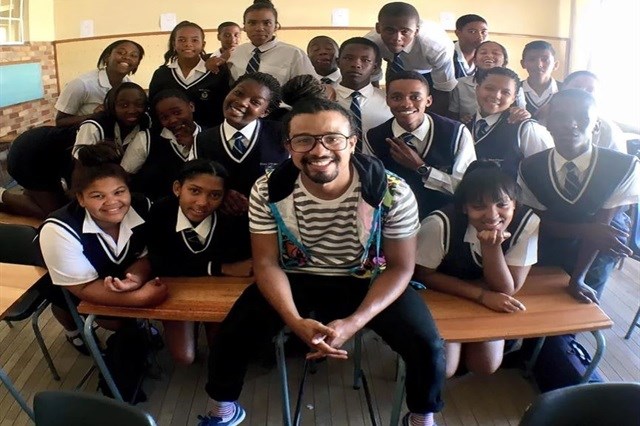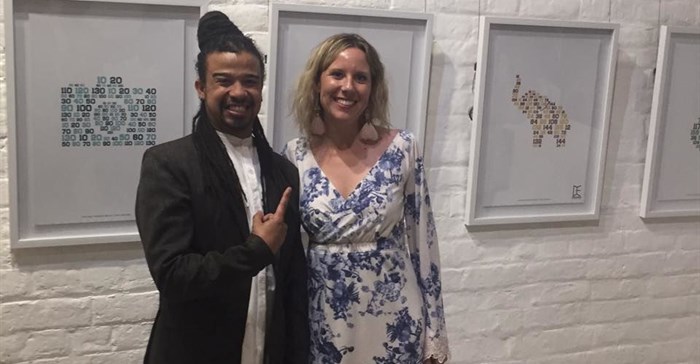Minnaar’s unconventionality challenges the status quo and addresses the needs of his learners by providing them with fresh, new and interesting ways to learn and understand mathematical concepts that could otherwise be problematic to understand.
Most recently, Minnaar teamed up with Youngblood Arts and Culture Development, situated in Cape Town, to create a month-long themed celebration titled Vanguard: A month where math meets art, which includes teacher and school learner workshops with a focus on maths concepts through dance and art.

We caught up with Minnaar to find out how introducing art to maths can change the education landscape, what makes it a good match for maths, and what we can do to incorporate these sort of teaching methods into the South African education system.
 How can music, dance and art change the education landscape?
How can music, dance and art change the education landscape?
I think that the youth is into art, dance and music. It’s kind of the thing at the moment. Not the thing it has always been. There’s something about art, dance and music that captures people’s attention, especially if you speak music. For instance, kids are into hip-hop at the moment, more than I would say rock music. I think why we use dance, art and maths together is because it holds attention, and a lot of the time the content in school is executed in a boring way and comes across really boring, and we know it isn’t, but the way it comes across, is.
The key was to merge the two properly, so that we can hold the kids' attention, and make it look beautiful, but also get through the important content that we want them to learn – also art, music and dance in itself are also art forms or occupations, jobs that people can actually walk into, so it’s a win-win either way.
So how will it? It will get the kids to listen in class, it will get kids and teachers to enjoy the lessons more, and it’s going to bring down discipline issues in the classroom. The last two years I noticed discipline issues and started bringing it into my class and it's improved.
Since I’ve done this, I’ve learnt the content and I’ve learnt the work so much faster myself, even at this age.
 What makes music, art and dance a good match for maths?
What makes music, art and dance a good match for maths?
I don’t have to speak about it, but the right-side of the brain is interested in playing music and interested in maths. That’s that on its own. Dance, we're talking about counts. If I’m teaching kids, something in the content or in maths, I teach them their timetables to a funky beat. There’s a rhythm and there’s a match in that sense, so to bring two different worlds together makes it more beautiful and makes it more fun and actually makes you want to learn. Then there’s dance, music we spoke about and art. Art is just art. It’s beautiful. If I had to show a kid a 360-degree angle with a piece of art, the kid is going to remember it. It’s difficult to forget such a beautiful piece of art, but if I had to do a plain page with a black line and black ink, nobody’s going to want to look at it. Visuals are so important.
 Why is it important to rethink teaching methods and change it up a bit?
Why is it important to rethink teaching methods and change it up a bit?
Last year, Professor Jonathan Jansen released a post that said: We fail in how we teach (in execution) and he said it. I am not the first to say this. We cannot teach and we cannot be boring and we cannot teach in a way that doesn’t relate to the kids. I feel like this education system is not the right fit for our kids. It will fit the older generation of today, maybe way back, but this is a new culture, so we need to relate to them, and at the moment, we’re losing. The results are speaking for themselves. So instead of us using social media and visuals properly to win our kids over, we let them use it to do other things. If we make proper use of it, maybe we can improve our maths marks.
Ultimately, we have to try something, because what we're doing now doesn’t work – our current leadership, politicians, and policymakers are not addressing this issue.
 What can we do to incorporate these kinds of education into our schooling systems?
What can we do to incorporate these kinds of education into our schooling systems?
At the base of what I am doing, now especially, is to train teachers, learners and families, etc. to incorporate this teaching method into where they’re at and share the knowledge that I have, but it’s also about research, to share what’s happening and implement it and try it in class.
 For this to be fully integrated into our schooling system, do you think how we educate our teachers should change? Or should the sector look at recruiting outside of graduates, for example, bring in dance teachers, etc.
For this to be fully integrated into our schooling system, do you think how we educate our teachers should change? Or should the sector look at recruiting outside of graduates, for example, bring in dance teachers, etc.
I think the integration of dance, everybody and everything, if you’re into it, is important. This collaboration of mine took place with dance and academics, but the truth is, my personal career so far has been one where my academic development and my artistic development was running parallel. I was always dancing and creating after Matric and then I studied and pursued my academic career (I am still studying today), so it has always been running parallel and I feel like that’s a method that we can use to educate our teachers, because at the moment, how we are training our teachers, I think, is not up to scratch, not at all.
What changed the game for me? When I use my videography knowledge, for example, in the classroom, it changes everything. I can personally create visuals I can control to stimulate my learners and make them excited about teaching and learning. Now when you don’t have that skill, it’s difficult. I’ve got circles around me where we can create music and create beats off-hand, but those are things teachers should learn now. We should reimagine teacher training, we should reimagine teaching and learning, because if we don’t, we’re going to keep on losing.
We’re hoping, in collaboration with SAE Institute South Africa, to offer the first videography training to teachers, especially in line with the lesson plans and how we should do it.
So in my capacity with my team, friends and family, we’ve been making moves. It’s just something that needs to be adopted by government – it has to be – because this has to be systemic, this cannot become a thing where I just go to schools, it has to become systemic and filter right through the system, then we're going to win and make moves to model it for the rest of the world.
We also caught up with Marie Vogts, managing director of Youngblood Arts and Culture Development to find out more about the partnership with Dreamers Education and the synergy behind the collaboration.

 Why partner with Youngblood – what are the synergies between Dreamers Education and Youngblood Art Gallery?
Why partner with Youngblood – what are the synergies between Dreamers Education and Youngblood Art Gallery?
We met outside at a concert last year December at a dance performance and someone said that I need to meet Kurt. I always wanted to study mathematics together with my drama and people told me I’m weird and that I couldn’t do it. Then when I got into mathematics, it was fascinating and I feel like the youth, it’s the future generation as such, and we do a lot of things here, often with kids, like singing and art ventures, etc. So when I heard Kurt's focusing on the foundation phase, I thought that this was the ideal space to tap in.
The synergies are the younger generation that we’re focusing on in order to establish a future where South Africa should be moving toward, but it’s also the necessity of art. People see art as a luxury, but I don’t see it as a luxury, I see it as a necessity, because take it away, then what’s left?
So when Kurt was incorporating that into the education system, I thought that this is perfect. For instance, when I was at school, I remember art was something that people bunked and didn’t want to go to and people had this stereotype about art as a waste of time and the fact that Kurt’s combining it and showing how art is actually making the kids think better, I think that was the most important aspect for me, realising the necessity in the education system.
The other big thing was the collaboration aspect and all the collaborators involved, some of which we’ve worked with in the past as well, but the biggest thing for me was the collaboration. I have never seen one like this, in terms of friends, and family and community support.
The next Maths meets Art session will take place on 19 October 2017 at 6.30pm at the Youngblood Art Gallery - for more information, visit the Vanguard: A month where math meets art on Facebook.